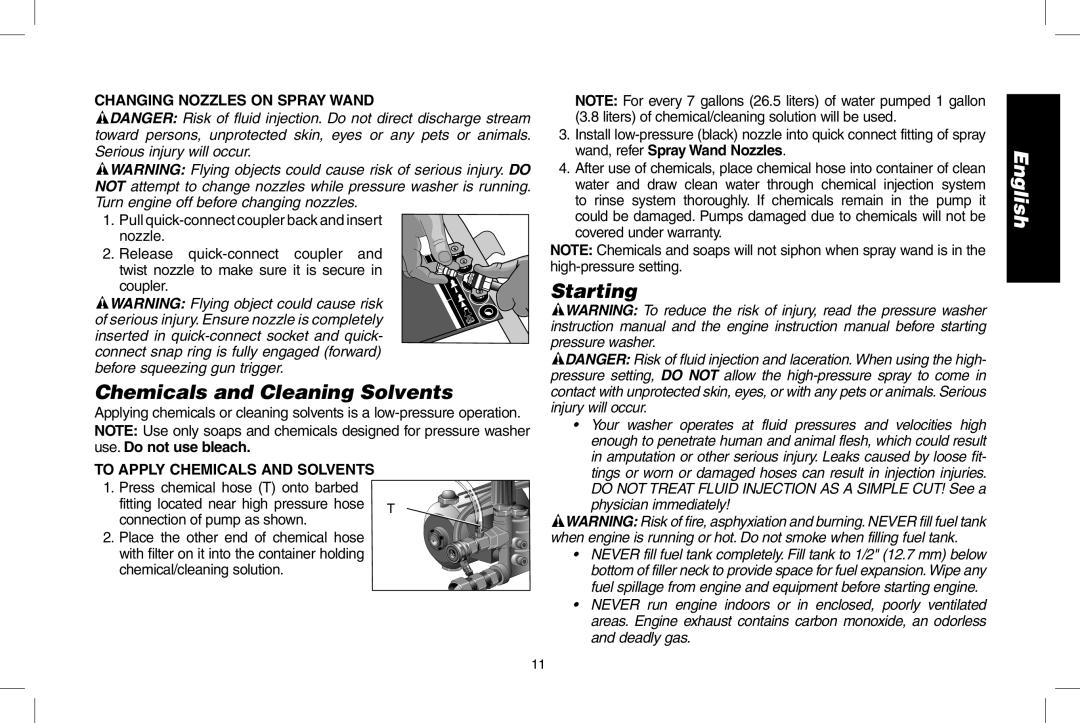
CHANGING NOZZLES ON SPRAY WAND
![]() DANGER: Risk of fluid injection. Do not direct discharge stream toward persons, unprotected skin, eyes or any pets or animals. Serious injury will occur.
DANGER: Risk of fluid injection. Do not direct discharge stream toward persons, unprotected skin, eyes or any pets or animals. Serious injury will occur.
![]() WARNING: Flying objects could cause risk of serious injury. DO NOT attempt to change nozzles while pressure washer is running. Turn engine off before changing nozzles.
WARNING: Flying objects could cause risk of serious injury. DO NOT attempt to change nozzles while pressure washer is running. Turn engine off before changing nozzles.
1.Pull
2. Release
![]() WARNING: Flying object could cause risk of serious injury. Ensure nozzle is completely inserted in
WARNING: Flying object could cause risk of serious injury. Ensure nozzle is completely inserted in
Chemicals and Cleaning Solvents
Applying chemicals or cleaning solvents is a
TO APPLY CHEMICALS AND SOLVENTS |
| |
1. | Press chemical hose (T) onto barbed |
|
| fitting located near high pressure hose | T |
| connection of pump as shown. | |
|
| |
2. | Place the other end of chemical hose |
|
| with filter on it into the container holding |
|
| chemical/cleaning solution. |
|
NOTE: For every 7 gallons (26.5 liters) of water pumped 1 gallon (3.8 liters) of chemical/cleaning solution will be used.
3.Install
4.After use of chemicals, place chemical hose into container of clean water and draw clean water through chemical injection system to rinse system thoroughly. If chemicals remain in the pump it could be damaged. Pumps damaged due to chemicals will not be covered under warranty.
NOTE: Chemicals and soaps will not siphon when spray wand is in the
Starting
![]() WARNING: To reduce the risk of injury, read the pressure washer instruction manual and the engine instruction manual before starting pressure washer.
WARNING: To reduce the risk of injury, read the pressure washer instruction manual and the engine instruction manual before starting pressure washer.
![]() DANGER: Risk of fluid injection and laceration. When using the high- pressure setting, DO NOT allow the
DANGER: Risk of fluid injection and laceration. When using the high- pressure setting, DO NOT allow the
•Your washer operates at fluid pressures and velocities high enough to penetrate human and animal flesh, which could result in amputation or other serious injury. Leaks caused by loose fit- tings or worn or damaged hoses can result in injection injuries. DO NOT TREAT FLUID INJECTION AS A SIMPLE CUT! See a physician immediately!
![]() WARNING: Risk of fire, asphyxiation and burning. NEVER fill fuel tank when engine is running or hot. Do not smoke when filling fuel tank.
WARNING: Risk of fire, asphyxiation and burning. NEVER fill fuel tank when engine is running or hot. Do not smoke when filling fuel tank.
•NEVER fill fuel tank completely. Fill tank to 1/2" (12.7 mm) below bottom of filler neck to provide space for fuel expansion. Wipe any fuel spillage from engine and equipment before starting engine.
•NEVER run engine indoors or in enclosed, poorly ventilated areas. Engine exhaust contains carbon monoxide, an odorless and deadly gas.
English
11
